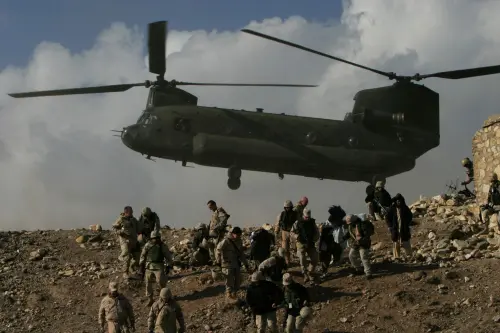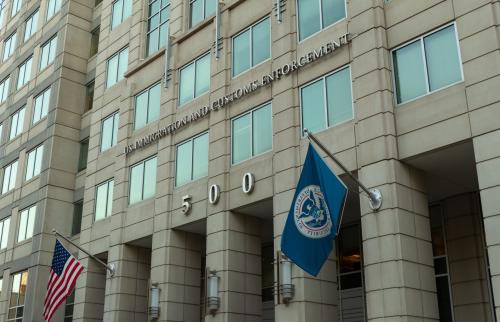In March I wrote a commentary for the Brookings-LSE Project on Internal Displacement considering lessons learned from responses to migration and displacement resulting from the events of the Arab Spring, focusing on the differential impacts of conflict on migration across the region, protection gaps for non-citizens who are displaced by political instability, and contrasting European and North African responses to migration and displacement.
This new commentary looks to the future, and identifies another three issues that are likely to dominate the migration and displacement policy agendas in the Middle East and North Africa (MENA) in the coming year.
New and Continuing Displacement
The most pressing issue is the new and continuing displacement occurring in several countries in the MENA region. Syria has dominated recent headlines: the Internal Displacement Monitoring Centre estimates that there are some 589,000 internally displaced persons (IDPs) in Syria, of whom at least 156,000 have been displaced over the last year, especially from Ma’arat al-Numaan, Homs and Jisr el-Soghour. At the same time, the Office of the United Nations High Commissioner for Refugees (UNHCR) estimates that there are over 88,000 registered Syrian refugees, in Lebanon, Jordan, Turkey and Iraq.
Conditions for those already displaced by the crisis in Syria are deteriorating. The International Committee of the Red Cross (ICRC) reports that the assets of many IDPs have been looted or destroyed; and that several public buildings where IDPs had been temporarily sheltering have been damaged and lack water and electricity. Meanwhile UNHCR has reported high levels of trauma and distress among Syrian refugee children, a shortage of food and a lack of basic household items for many refugees. Its regional appeal issued in March 2012 for US$84 million was funded at only 36 percent in May.
Yet as Syria descends into a full-scale civil war – as it was described last week by UN Under-Secretary for Peacekeeping Operations Hervé Ladsous – it is unlikely that the “massive increase in the level of violence” that Mr. Ladsous described will not result in significant new displacements. As an indication, the attack on Taldaw on the Houla plain during the night of 25-26 May resulted in thousands fleeing their homes, according to the ICRC.
Of particular concern is to what extent this violence will affect the significant number of refugees currently hosted in Syria. UNHCR provides assistance to around 100,000 Iraqi refugees in Syria (the Syrian government estimates that there are one million Iraqi refugees in the country) and there have been reports that some Iraqis are now returning home from Syria to escape the violence there. As observed at a recent Brookings-LSE Project on Internal Displacement roundtable, the ongoing unrest in Syria makes it difficult to discuss durable solutions for Iraqis who remain there. In addition, there are also almost half a million Palestinian refugees in Syria. Elements of the Syrian regime have accused the Palestinians of supporting the revolution, and some analysts are concerned about the risk of a direct attack by the regime on the Palestinian refugee camps. More likely is that the situation of generalized violence reaches the camps and displaces some of the Palestinians. In this scenario there are particular concerns about whether any of Syria’s neighbors would accept Palestinians in their territories, or whether they will simply swell the number displaced within Syria.
While Syria is understandably the focus of attention, it should not distract from other significant recent displacements across the MENA region. In Yemen, at least 175,000 people are estimated to have been newly displaced by armed conflict in 2011 – 90,000 alone from Zinjibar, the capital of Abeyan governorate. And although the majority of the half million or so people who were displaced last year inside Libya have since returned home, an estimated 70,000 remain internally displaced, with particular concerns about the fates of Qaddafi loyalists, and reintegrating IDPs poses significant challenges especially relating to the restitution of property.
Filling the Protection Gap for Foreign Nationals
My earlier commentary highlighted how the half a million or so foreign nationals displaced by the violence in Libya fell into a legal grey zone and relied on ad hoc coordination between UNHCR and the International Organization of Migration (IOM). The evacuation of migrant workers was largely effective, and the majority has since returned to their countries of origin. At least some foreign nationals, however, remain displaced and vulnerable inside Libya, in particular sub-Saharan Africans. And IOM has reported that significant challenges around employment, financial support, daily expenses and housing, are faced by returnees from Libya to West Africa, especially women. A further challenge will be to attract foreign nationals back to Libya, given that their labor was particularly important in the oil industry.
This was not the first time that foreign nationals have been displaced by conflict and violence – although the scale and the variety of different nationalities affected was probably unprecedented – and it will not be the last. There are indications that certain states and the international community have been spurred into action by the events in Libya to begin to plan responses to future displacements of foreign workers.
Some of those evacuated from Libya originated in South and South East Asia – over 36,000 from Bangladesh alone, for example. At the Fourth Ministerial Consultations of the Labour Sending Countries in Asia (the Colombo Process) in April 2011 in Dhaka, a roundtable session discussed institutionalized responses during emergencies impacting migrant workers. A series of recommendations were made, including for the appointment of national focal points in countries of origin to coordinate the various ministries and agencies involved along with consular activities in the affected country. It was noted for example that different ministries had managed the evacuation of Bangladeshi migrant workers after the first Gulf War and the Libya crisis, resulting in little institutional memory. The meeting also recommended the development of agreed principles and procedures for the protection of migrant workers in complex emergencies, including information for migrants on in-situ protection measures, relocation, and evacuation and repatriation procedures. Also during the Libyan crisis, the Philippines created an Overseas Preparedness and Response Team within the Office of the President, tasked with formulating and periodically reviewing contingency plans in times of crises affecting Filipinos overseas. The Colombo Process and other regional bodies were identified as appropriate mechanisms for sharing experience and effective practice.
At the level of international institutions, the focus for IOM’s annual International Dialogue on Migration in 2012 was ‘Migration Consequences of Complex Crises.’ Among the chair’s recommendations were: greater coordination between humanitarian, migration and development policies and actors in order to better integrate the different principles and procedures often adopted in these separate realms; and more coherent links between short-, medium- and long-term responses. Another recommendation was for vulnerability mapping, acknowledging that existing categories for crisis-affected populations do not always capture the vulnerabilities experienced by those displaced in crises. A third recommendation was for more innovative partnerships between the various U.N. agencies, international and non-governmental agencies involved in migration crises such as Libya, but also including a role for the private sector. There may, for example, be a role for the private sector in the provision of micro-insurance to migrants to help them cope with emergency situations.
Developing Regional Protection Frameworks
The role of governments in the Middle East and North Africa in responding to migration and displacement in the region has been important but limited. On the one hand Egypt and Tunisia deserve credit for keeping their borders open, guaranteeing access for international organizations and diverting significant funding to provide emergency services at the borders. On the other hand UNHCR and IOM were primarily responsible for protecting the displaced and finding solutions for them, while still other displaced persons were assisted directly by local communities. The Egyptian government has been criticized for not protecting refugees and migrants during the revolution there; the Tunisian government for not preventing tens of thousands of people leaving its shores in boats bound for Europe; and both governments for placing considerably more restrictions on sub-Saharan Africans displaced from Libya than Libyan migrants and refugees.
Of course there are extenuating circumstances: Egypt and Tunisia have both experienced their own revolutions and are undergoing political transformations. They are at best lower middle-income countries and still recovering from the effects of the global financial crisis; and the scale, speed and complexity of the displacement from Libya were unprecedented. But these should not divert attention from the fact that in Egypt and Tunisia, and across the Middle East and North Africa more generally, the legal framework and institutional infrastructure for protecting and assisting displaced people are poorly developed. There are hopes that the recent transitions may provide an opportunity for reform.
Most fundamentally, Jordan, Iraq, Libya and Syria are not signatories of the 1951 Refugee Convention and its 1967 Protocol, although Libya is a signatory to the 1969 Organization of African Unity (OAU) convention on refugees. The 1951 Convention is the key legal document in defining who are refugees, their rights, and the legal obligations of states. Even in those countries in the region that are signatories, international protection principles have tended to be poorly applied. Neither Egypt nor Tunisia, for example, has a national asylum law. In practice this has meant that for decades Tunisia has denied access to asylum; while in Egypt refugees have effectively been barred from achieving local reintegration (particularly access to employment and services). While maintaining its own capacity, UNHCR is currently working with the new governments in Egypt and Tunisia to strengthen national legislation and institutional capacity for asylum and refugee protection, including through awareness-raising, training on refugee law, and developing capacity for registration, documentation, refugee status determination and durable solutions, including local integration.
While there is no legal convention on internal displacement with universal scope, at least 24 states worldwide have developed national laws and policies relating to IDPs, – some of which draw on the 1998 Guiding Principles on Internal Displacement – and the African Union Convention on Protection and Assistance to Internally Displaced Persons, based on the Guiding Principles, is the first binding legal instrument intended to address internal displacement across an entire continent. But other than Iraq and Turkey, no state in the MENA region has any IDP legislation. It is clear from Brookings’ index of national IDP laws and policies that many states have developed legislation only after having been directly affected by internal displacement, and it may be that the significant internal displacement over the last year provides a similar impetus in the MENA region. At the same time, it is important to recognize that national laws and policies are just the first step in developing an effective response to internal displacement, as illustrated in a recent assessment of national responses to internal displacement by Elizabeth Ferris, Erin Mooney and Chareen Stark.
Finally, there may be scope to mobilize greater attention on protection frameworks at the regional level. To be sure, during the recent crises in the region the Arab League has been involved in political and diplomatic processes, while the Organization of Islamic Cooperation (OIC) and the humanitarian department of the League of Arab States (LAS) have supported the international humanitarian response in the region. But unlike the cases of Africa and Latin America, MENA has never had a regional refugee convention that adapts the 1951 Convention to regional specificities, despite the Islamic tradition of providing asylum and hospitality. Similarly, while there are examples of regional instruments relating to internal displacement in the Commonwealth of Independent States (CIS), Europe, the Great Lakes region, Latin America, the Organization of American States (OAS) and most recently the African Union (AU), there are no such regional instruments in the Middle East.
Much of the optimism about the Arab Spring has subsided in recent months, as we witness Syria’s descent into civil war and ongoing unrest in Yemen, and realize in Egypt, Libya and Tunisia – in contrast to the revolutions that brought about such rapid change – the transitions they are now navigating are difficult, complex, lasting longer and could fail. This uneasy mix of optimism and pessimism also extends to the realms of migration and displacement in the region. On the one hand violence in Syria is likely to generate more displacement and to impact Iraqi and Palestinian refugees in Syria; internal displacement continues to rise in Yemen; and there are uncertainties about prospects for those who remain displaced in Libya. On the other hand, displacement over the last year has exposed an important gap in the migration regime pertaining to foreign citizens, and there are positive signs that this gap may be filled quickly. And direct experience of displacement, combined with regime change based on concerns about dignity, rights, social justice, legitimate governance and representative democracy, should provide an opportunity to strengthen international protection principles, at both the national and regional levels.
The Brookings Institution is committed to quality, independence, and impact.
We are supported by a diverse array of funders. In line with our values and policies, each Brookings publication represents the sole views of its author(s).



Commentary
Op-edMigration, Displacement and the Arab Spring: Prospects for the Next Year
July 2, 2012